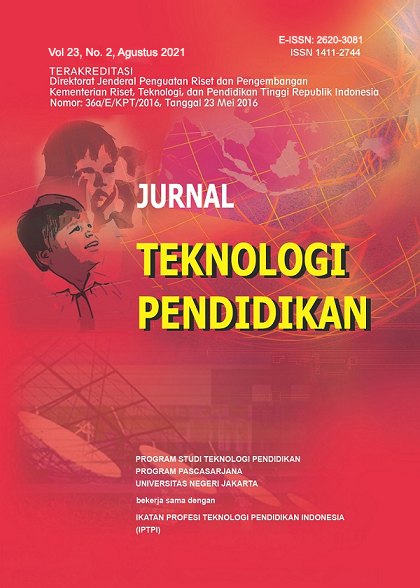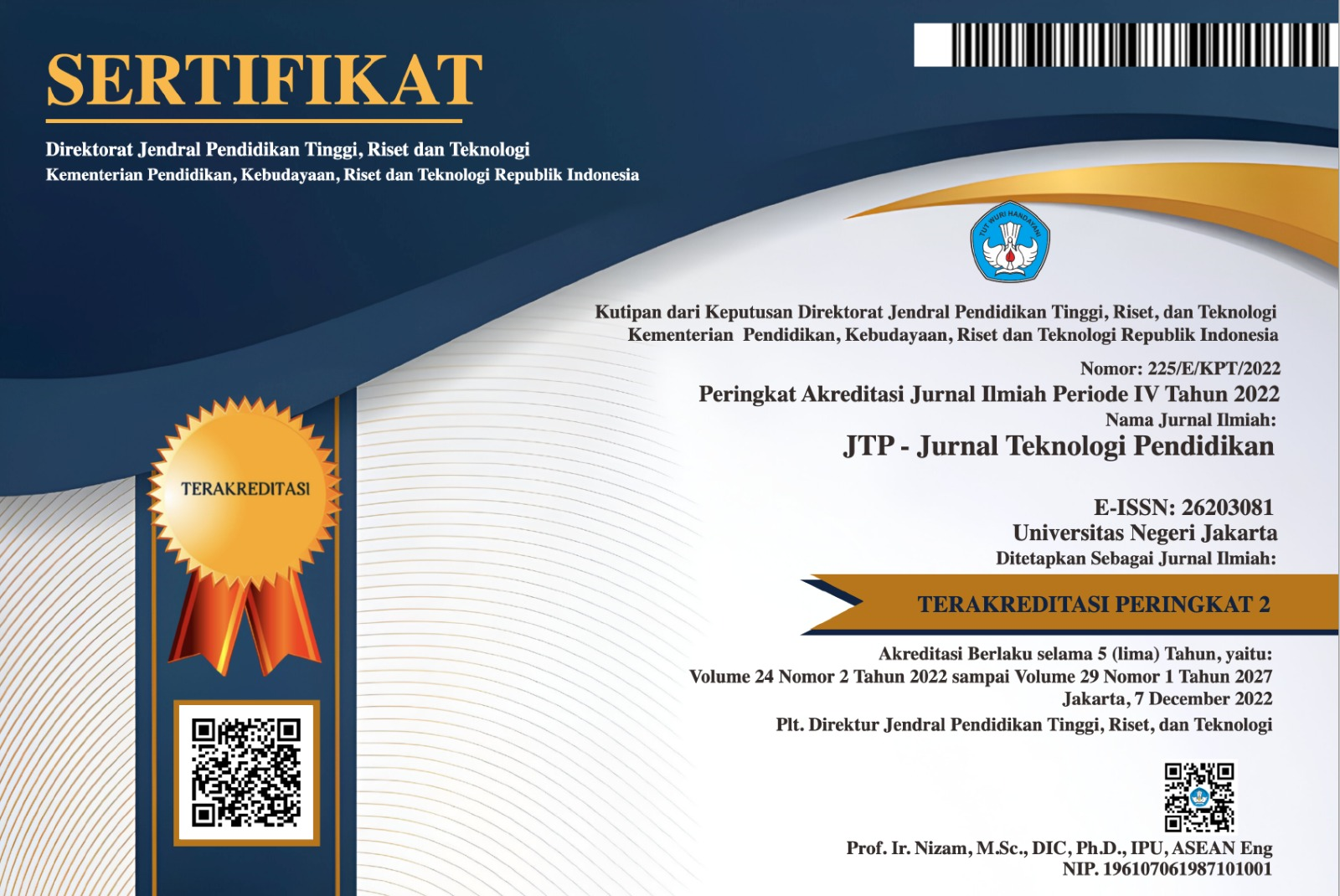Canva Application Development for Distance Learning on Arabic Language Learning in MTs Thawalib Tanjung Limau Tanah Datar
DOI:
https://doi.org/10.21009/jtp.v23i2.20650Keywords:
Canva Application, distance learning, Arabic Language LearningAbstract
This study aims to find out the effectiveness and practicality of Canva applications that can be used online in Video format. The video is developed as a learning medium during distance learning for Arabic language learning. The method used in this study is the R & D (Research and Development) method by following the Borg and Gall models. This research model has ten steps of development, these are: 1) Research and information collection, 2) Planning, 3) Develop a preliminary form of product, 4) Preliminary field testing, 5) Main product revision, 6) Main field testing, 7) Operation product revision, 8) Operational field testing, 9) Final product revision, 10) Dissemination and implementation. This study only comes to the sixth step which at that step focuses only on field trials. The results of the field trials are the results of content verification on audiovisual learning media using the Canva application for distance learning with an average of 4.66 or in an excellent category with a maximum score of 5.00. While the average field test score on students' responses to learning media using the Canva app for distance learning is 3.78 and the maximum score is 5.00.
References
Alessi, S. M., & Trollip, S. R. (2001). Multimedia for Learning: Methods and Development. European Journal of Education Studies, 1(1), 50–56. http://oapub.org/edu/index.php/ejes/article/view/5/53
Bakri, N. F., Simaremare, E. S., Lingga, I. S., Susilowaty, R. A., Farmasi, J., Matematika, F., Alam, P., & Cenderawasih, U. (2021). Jurnal Ilmiah Pro Guru , Vol . 7 No . 1 , Januari 2021 ISSN : 2442 – 2525 , E _ ISSN : 2721-7906 PELATIHAN PEMBUATAN MATERI PRESENTASI DAN VIDEO PEMBELAJARAN MENGGUNAKAN APLIKASI CANVA KEPADA GURU DI KOTA MEDAN DAN JAYAPURA SECARA ONLINE Jurnal Ilmiah Pro. 7(1), 1–10. http://journal2.um.ac.id/index.php/jipg/article/view/18777
Becker, S. R., & Sturm, J. L. (2017). Effects of audiovisual media on L2 listening comprehension: A preliminary study in French. CALICO Journal, 34(2), 147–177. https://doi.org/10.1558/cj.26754
Bennett, N., Borg, W. R., & Gall, M. D. (1984). Educational Research: An Introduction. British Journal of Educational Studies, 32(3), 274. https://doi.org/10.2307/3121583
Bylund, E., & Athanasopoulos, P. (2015). Televised Whorf: Cognitive Restructuring in Advanced Foreign Language Learners as a Function of Audiovisual Media Exposure. The Modern Language Journal, 99(S1), 123–137. https://doi.org/10.1111/j.1540-4781.2015.12182.x
Canva. (n.d.). (2020). Canva Untuk Pendidikan. https://www.canva.com/id_id/pendidikan/
Ferry Aristya, Ayatullah Muhammadin Al Fath, Zuniar Kamaluddin Mabruri, N. P. P. (2020). PEMANFAATAN GOOGLE FORM DAN OFFIE 365 UNTUK MENINGKATKAN KUALITAS GURU DALAM PEMBELAJARAN DARING DI SEKOLAH DASAR. PROSIDING SEMINAR NASIONAL DALAM JARINGAN HASIL PENELITIAN DAN ABDIMAS TAHUN 2020, 313–319. https://lppm.stkippacitan.ac.id/?page_id=2719
Hamid, A. (2020). Pemanfaatan Aplikasi Zoom Meeting dalam Proses Pembelajaran di Masa Pandemi Covid-19 Pada Mahasiswa Jurusan Pendidikan IPS FKIP Universitas Tadulako. Jurnal Pendidikan Ilmu Sosial, 17(2), 166–174. http://jurnal.fkip.untad.ac.id/index.php/jurpis/article/view/632
Handarini, O. I., & Wulandari, S. S. (2020). Pembelajaran Daring Sebagai Upaya Study From Home (SFH) Selama Pandemi Covid 19. Jurnal Pendidikan Administrasi Perkantoran (JPAP), 8(3), 465–503. https://journal.unesa.ac.id/index.php/jpap/article/view/8503
Haqien, D., & Rahman, A. A. (2020). Pemanfaatan Zoom Meeting untuk Proses Pembelajaran pada Masa Pandemi Covid-19. SAP (Susunan Artikel Pendidikan), 5(1). https://doi.org/10.30998/sap.v5i1.6511
Herliandry, L. D., Nurhasanah, Suban, M. E., & Heru, K. (2020). Transformasi Media Pembelajaran Pada Masa Pandemi Covid-19. Jurnal Teknologi Pendidikan, 22(1), 65–70. http://journal.unj.ac.id/unj/index.php/jtp
Leryan, L. P. A., Damringtyas, C. P., Hutomo, M. P., & Printina, B. I. (2018). the Use of Canva Application As an Innovative Presentation Media Learning History. 190–203. https://doi.org/10.24071/snfkip.2018.20
Mahayoni, N. M. S. (2020). Penggunaan Aplikasi Zoom Meeting Pada Pembelajaran Agama Hindu Di Masa Pandemi. Jurnal Widya Sastra Pendidikan Agama Hindu, 3(1), 47–53. https://www.jurnal.stkipahsingaraja.ac.id/index.php/wspah/article/view/67
Mareta, P. R., Arif M, A., & Susanto, S. (2021). The Social Skills of Students in the Pandemic Period (The Case Study in SMAN 1 Kedunggalar, Ngawi District, East Java, Indonesia). Budapest International Research and Critics in Linguistics and Education (BirLE) Journal, 4(1), 369–376. https://doi.org/10.33258/birle.v4i1.1618
Mohammad Imam Farisi. (2021). KARAKTER DAN PENGEMBANGANNYA DALAM SISTEM PENDIDIKAN JARAK JAUH. Jurnal Pendidikan Terbuka Dan Jarak Jauh, 13. http://www.jurnal.ut.ac.id/index.php/jptjj/article/view/411
Muhammad Suyanto. (2003). Multimedia Alat untuk Meningkatkan Keunggulan Bersaing. Penerbit: Andi. https://books.google.co.id/books?hl=en&lr=&id=3uAMIBpFfoUC&oi=fnd&pg=PA255&ots=_HcifI9EHo&sig=PtDZy-wGZ8WxpTGi9FWKr9aIoiI&redir_esc=y#v=onepage&q&f=false
Pelangi, G. (2020). Pemanfaatan Aplikasi Canva sebagai Media Pembelajaran Bahasa dan Sastra Indonesia Jenjang SMA/MA. Jurnal Sasindo UNPAM, 2(8), 79–96. http://dx.doi.org/10.32493/sasindo.v8i2.79-96
Purwati, YuliPerdanawanti, L. (2019). PELATIHAN DESAIN MENGGUNAKAN APLIKASI CANVA UNTUK ANGGOTA KOMUNITAS IBU PROFESIONAL BANYUMAS RAYA. JPMM (Jurnal Pengabdian Mitra Masyarakat), 1(1), 42–51. https://ejournal.amikompurwokerto.ac.id/index.php/jpmm/article/view/821
Rahmatullah, R., Inanna, I., & Ampa, A. T. (2020). Media Pembelajaran Audio Visual Berbasis Aplikasi Canva. Jurnal Pendidikan Ekonomi Undiksha, 12(2), 317–327. https://ejournal.undiksha.ac.id/index.php/JJPE/article/view/30179
Sadikin, A., & Hamidah, A. (2020). Pembelajaran Daring di Tengah Wabah Covid-19. BIODIK, 6(2), 109–119. https://doi.org/10.22437/bio.v6i2.9759
Sadra, I. W. (2007). Pengembangan Model Pembelajaran Matematika Berwawasan Lingkungan dalam Pelatihan Guru Kelas 1 Sekolah Dasar. Diseratasi. https://scholar.google.com/scholar?cluster=5352253412164365115&hl=en&oi=scholarr
Sugiyono. (2008). Metode penelitian pendidikan:(pendekatan kuantitatif, kualitatif dan R & D). Alfabeta. https://scholar.google.com/scholar?cluster=10328650190657588078&hl=en&oi=scholarr
Tanjung, R. E., & Faiza, D. (2019). CANVA SEBAGAI MEDIA PEMBELAJARAN PADA MATA PELAJARAN DASAR LISTRIK DAN ELEKTRONIKA. Jurnal Vokasional Teknik Elektronika Dan Informatika, 7(2), 79–85. http://ejournal.unp.ac.id/index.php/voteknika/article/view/104261
Wayan Ardhana. (2002). Konsep penelitian pengembangan dalam bidang pendidikan dan pembelajaran. Universitas Negeri Malang. https://scholar.google.com/scholar?cluster=10113727944295505425&hl=id&as_sdt=2005&sciodt=0,5s
Widoyoko, E, P. (2009). Evaluasi Program Pembelajaran. Yogyakarta: Pustaka Pelajar, 283. https://www.academia.edu/download/33381764/Evaluasi_Program_Pembelajaran.pdf
Zainal Arifin. (2012). Penelitian pendidikan: metode dan paradigma baru. Bandung: Remaja Rosda karya. https://pdfs.semanticscholar.org/8b11/a752f5f7142f4d5191fb70b0cc916c76752d.pdf
Downloads
Published
How to Cite
Issue
Section
License
Jurnal Teknologi Pendidikan is an Open Access Journal. The authors who publish the manuscript in Jurnal Teknologi Pendidikan agree to the following terms.
Attribution-ShareAlike 4.0 International (CC BY-SA 4.0)
-
Attribution — You must give appropriate credit, provide a link to the license, and indicate if changes were made. You may do so in any reasonable manner, but not in any way that suggests the licensor endorses you or your use.
-
ShareAlike — If you remix, transform, or build upon the material, you must distribute your contributions under the same license as the original.
- No additional restrictions — You may not apply legal terms or technological measures that legally restrict others from doing anything the license permits.
Notices:
- You do not have to comply with the license for elements of the material in the public domain or where your use is permitted by an applicable exception or limitation.
- No warranties are given. The license may not give you all of the permissions necessary for your intended use. For example, other rights such as publicity, privacy, or moral rights may limit how you use the material.








